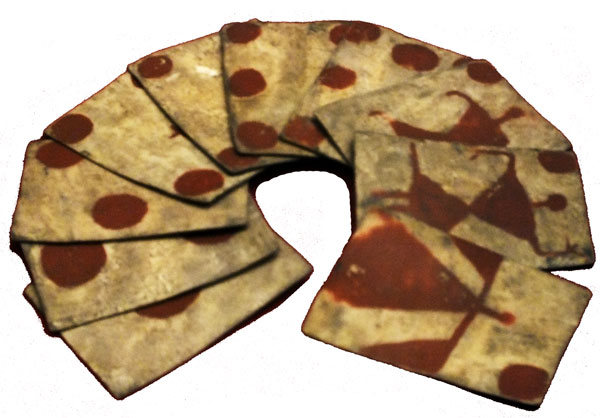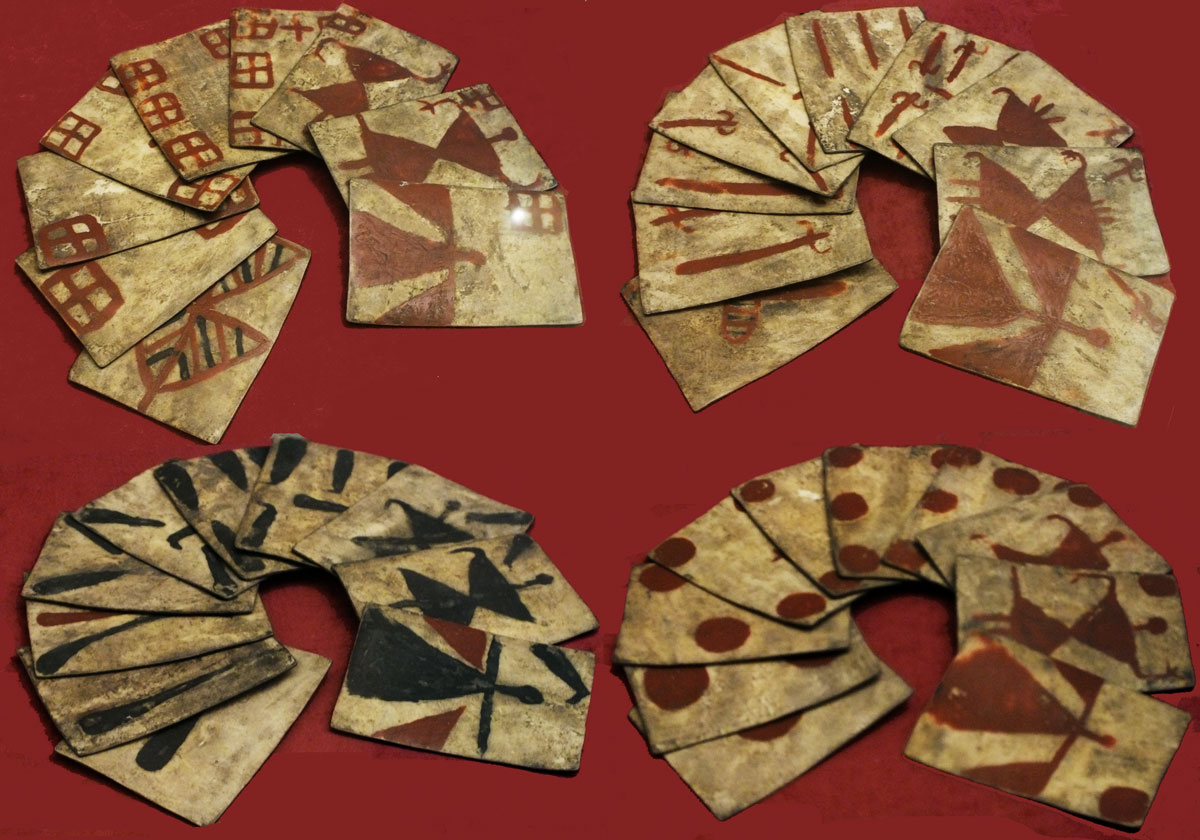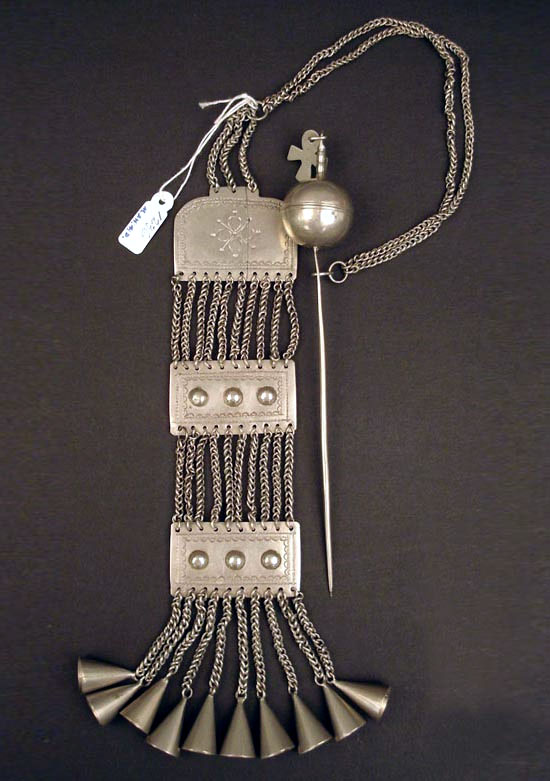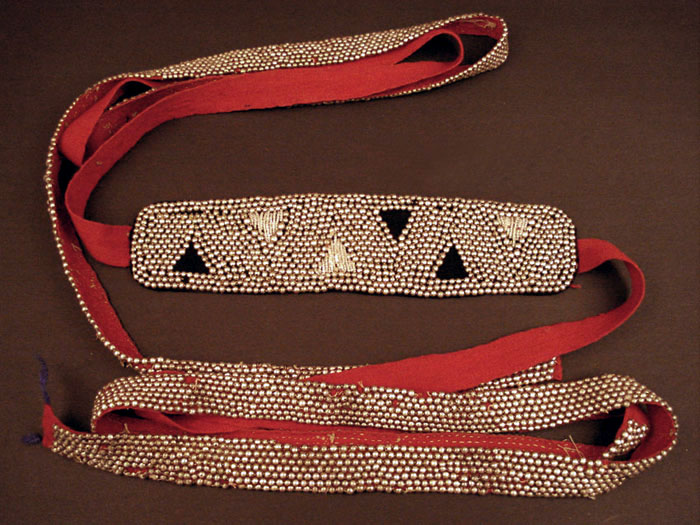Mapuche Indian Playing Cards
Spanish-suited playing cards made on rawhide and said to have been used by Chilean Mapuche Indians, XVI-XVII century

Spanish-suited playing cards made on rawhide and said to have been used by Chilean Mapuche Indian men, XVI-XVII century. We know that Spanish soldiers commenced colonising South American territories from the early 16th century and were also heavy gamblers. At the same time, the Indians captured firearms, horses and other items from the intruders which changed their way of life. These cards appear to have been copied from 40-card Spanish models by a draughtsman unfamiliar with finer details of Spanish playing card pictures but who somehow imitated their basic shape and layout so that they could be used for playing Monte.

Above: Spanish-suited playing cards made on rawhide by the Mapuche Indians, Chile, XVI-XVII century. 39 cards. Image courtesy the Museo de América (Madrid) Inv. No. 13.638/676.

Above: Mapuche jewelry, 635mm x 50mm. Museo Chileno de Arte Precolombino.
Mapuche art also includes metal-work, jewelry, pottery, weaving, music and dance, with instruments such as the kultrún and truruka used to produce the unique sounds that characterize traditional rites celebrating the Mapuche cosmovision and cycle of life.

Above: Mapuche textile, 3920mm x 70mm. Museo Chileno de Arte Precolombino.

By Simon Wintle
Member since February 01, 1996
I am the founder of The World of Playing Cards (est. 1996), a website dedicated to the history, artistry and cultural significance of playing cards and tarot. Over the years I have researched various areas of the subject, acquired and traded collections and contributed as a committee member of the IPCS and graphics editor of The Playing-Card journal. Having lived in Chile, England, Wales, and now Spain, these experiences have shaped my work and passion for playing cards. Amongst my achievements is producing a limited-edition replica of a 17th-century English pack using woodblocks and stencils—a labour of love. Today, the World of Playing Cards is a global collaborative project, with my son Adam serving as the technical driving force behind its development. His innovative efforts have helped shape the site into the thriving hub it is today. You are warmly invited to become a contributor and share your enthusiasm.
Related Articles

French Revolutionary cards by Pinaut
Seven cards from a French Revolutionary pack by Pinaut featuring characters from classical antiquity...

Visite Mexico
Promoting Mexican tourism with 54 different photographs in full colour.

Mexican ethnic playing cards
Mexican ethnic groups depicted on playing cards by Fábrica de Naipes Cuauhtemoc.

Rouen Pattern - Portrait Rouennais
An attractive XV century French-suited design from Rouen became the standard English & Anglo-America...

Colonial Art
A collection of 53 pieces of art showcasing detailed scenes from early American colonial life.

Ganjifa - Playing Cards from India
Indian playing cards, known as Ganjifa, feature intricate designs with twelve suits and are traditio...

The Henry Hart Puzzle
Explore the intricate history and unique design variations of Henry Hart's playing cards, tracing th...

Sevilla 1647 reproduction
Facsimile of Spanish-suited pack produced in Sevilla, Spain, 1647.

Why our playing-cards look the way they do
Analysis of early playing card designs: origins, suit differences, standardization, technological ad...

Introduction to Collecting Themes
Playing cards can be broadly categorised into standard and non-standard designs, with collectors app...

Le Monde Primitif Tarot
Facsimile edition produced by Morena Poltronieri & Ernesto Fazioli of Museo Internazionale dei Taroc...

Mardi Gras playing cards
Mardi Gras playing cards illustrated by Dave Edgerly, USA, 2015

75: Early American cards
An overview of some of the early cards made in the United States.

Aztec Codex playing cards
Aztec Codex playing cards illustrated by Emmanuel Valtierra, USA, ©2015.

Malam playing cards
Malam playing cards created by Michael Muldoon, USA, 2015.

Early German playing cards
Some early examples of popular German playing cards from the XV and XVI centuries.
Most Popular
Our top articles from the past 28 days

